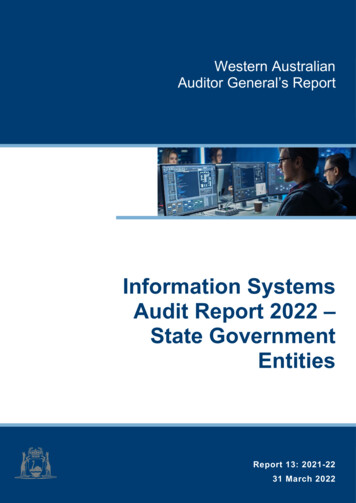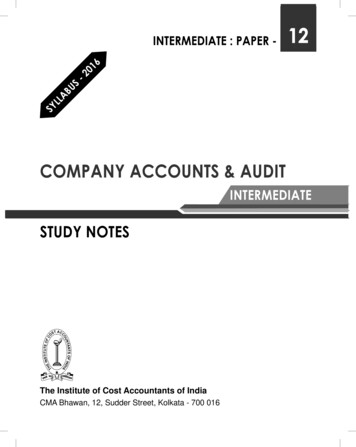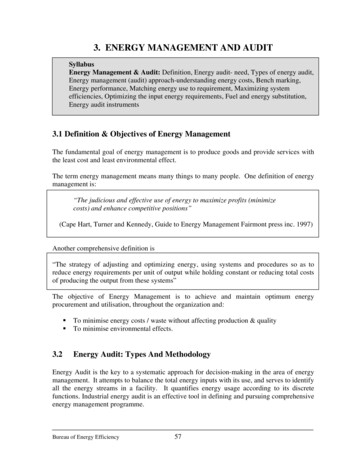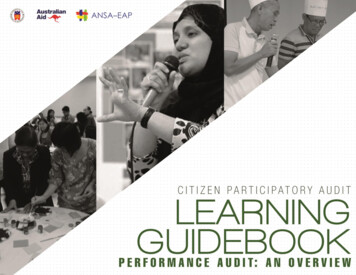
Transcription
Western AustralianAuditor General’s ReportInformation SystemsAudit Report 2022 –State GovernmentEntitiesReport 13: 2021-2231 March 2022
Office of the Auditor GeneralWestern AustraliaAudit team:Aloha MorrisseyKamran AslamPaul TilbrookFareed BakhshMichael ChumakBen GoodwinKhubaib GondalReshma VikasSayem ChowdhurySvetla AlphonsoGhulam WahidTuck OwyongIzak de VriesXuan OngNational Relay Service TTY: 133 677(to assist people with hearing and voice impairment)We can deliver this report in an alternative format forthose with visual impairment. 2022 Office of the Auditor General Western Australia.All rights reserved. This material may be reproduced inwhole or in part provided the source is acknowledged.ISSN: 2200-1913 (print)ISSN: 2200-1921 (online)The Office of the Auditor General acknowledges the traditional custodians throughoutWestern Australia and their continuing connection to the land, waters and community. Wepay our respects to all members of the Aboriginal communities and their cultures, and toElders both past and present.
WESTERN AUSTRALIAN AUDITOR GENERAL’S REPORTInformation Systems Audit Report 2022 –State Government EntitiesReport 13: 2021-22March 2022
This page intentionally left blank
THE PRESIDENTLEGISLATIVE COUNCILTHE SPEAKERLEGISLATIVE ASSEMBLYINFORMATION SYSTEMS AUDIT REPORT 2022 – STATE GOVERNMENT ENTITIESThis report has been prepared for submission to Parliament under the provisions of section 24of the Auditor General Act 2006.Our information systems audits focus on the computer environments of entities to determineif their general computer controls effectively support the confidentiality, integrity andavailability of information systems and the information they hold.This is the 14th year we have separately reported on State government entities’ generalcomputer controls.I wish to acknowledge the entities’ staff for their cooperation with this audit.CAROLINE SPENCERAUDITOR GENERAL31 March 2022
ContentsAuditor General’s overview . 2Introduction . 3Conclusion . 4What we found: General computer controls. 6What we found: Capability assessments . 7Information security . 9Business continuity.13Management of IT risks .15IT operations .15Change control .17Physical security .19Recommendations .20Appendix 1: Control categories in our updated capability maturity model (for 2022audits) . 21
Auditor General’s overviewThis report summarises the results of the 2020-21 annual cycle ofinformation systems audits for State government entities and tertiaryinstitutions in the Western Australian public sector. These audits wereperformed between February 2021 and February 2022.Global trends show more organisations are experiencing information andcybersecurity attacks. Compromise of supply chains, ransomware, andexploitation of vulnerabilities remain high. Government entities are not immune to theseattacks as they deliver key services and hold valuable citizen data. As internal and externalthreats continue to evolve it is important that entities constantly improve the key controls thatprotect their information systems and IT environments from information and cybersecurityrisks.This year’s audits show many entities are still not addressing audit findings quickly, withnearly half of all findings previously reported remaining unresolved by the following year'saudit. It is also disappointing that many entities continue to have poor controls overinformation security. Only 50% of entities met our benchmark in this area, with no noticeableimprovement from the previous year. These results contributed to the highest number ofqualified opinions on financial statements, controls or key performance indicators everreported by my Office in 2020-21 1. Effective general computer controls support entities toachieve their objectives and defend against information systems’ compromise and databreaches.It is promising to see more entities this year met our benchmark consistently in all 6 generalcomputer control categories, building on a positive trend. Nine entities compared to 5 lastyear. To further help entities, we have modernised our capability maturity model for use inour 2022 audits. The new model builds upon the previous model and provides increasedguidance on information and cybersecurity controls (Appendix 1).I encourage entities to take note of the recommendations in this report as they work toimprove their general computer controls, ensuring information security remains a heightenedarea of focus. This is an area that without constant effort, entities will go backwards in theirsecurity environment, exposing their systems, their operations and citizen data to harm.Western Australian Auditor General’s Report, Audit Results Report – Annual 2020-21 Financial Audits of State GovernmentEntities, Report 10: 2020-211Information Systems Audit Report 2022 – State Government Entities 2
IntroductionThis is our 14th report on the audits of State government entities’ general computer controls(GCC). The objective of our GCC audits is to determine whether entities’ computer controlseffectively support the confidentiality, integrity and availability of information systems. Thesecontrols are important to protect information systems and IT environments from informationand cybersecurity risks.For 2020-21, we reported GCC findings to 54 State government entities (Table 1). Weprovided 36 of the 54 entities with capability maturity self-assessments. These assessmentslook at how well-developed and capable entities’ established IT controls are. We thencompared their self-assessments with results from our GCC audits.36 entities issued GCC findings and capability assessmentsCentral RegionalTAFECurtin UniversityDepartment ofBiodiversity,Conservation andAttractionsDepartment ofCommunitiesDepartment ofEducationDepartment ofFinanceDepartment of Jobs,Tourism, Science andInnovationDepartment of JusticeDepartment of LocalGovernment, Sportand Cultural IndustriesDepartment ofPlanning, Lands andHeritageDepartment of thePremier and CabinetDepartment ofPrimary Industries andRegionalDevelopmentDepartment ofTraining andWorkforceDevelopmentDepartment ofTransportDepartment ofTreasuryDepartment of Waterand EnvironmentalRegulationDisability ServicesCommissionEast MetropolitanHealth ServiceEdith CowanUniversityHealth SupportServicesHousing AuthorityWestern AustralianLand InformationAuthority (trading asLandgate)Lotteries Commission(trading asLotterywest)Commissioner of MainRoadsMurdoch UniversityNorth MetropolitanTAFENorth Regional TAFERacing and WageringWestern AustraliaRottnest IslandAuthoritySouth MetropolitanHealth ServiceSouth MetropolitanTAFESouth Regional TAFEThe University ofWestern AustraliaWA Country HealthServicePolice ServiceWestern AustralianTourism Commission18 entities issued GCC findings onlyAnimal ResourcesAuthorityBotanic Gardens andParks AuthorityDepartment of Fireand EmergencyServicesDepartment of HealthElectricity Generationand Retail Corporation(trading as Synergy)Electricity NetworksCorporation (tradingas Western Power)Kimberley PortsAuthorityMental HealthCommissionNorth MetropolitanHealth ServiceOffice of theInformationCommissionerPathWest LaboratoryMedicine WAPilbara Ports Authority3 Western Australian Auditor General
Public TransportAuthority of WesternAustraliaWater CorporationWestern AustralianTreasury CorporationZoological ParksAuthorityWestern AustralianLand AuthorityWestern AustralianSports Centre Trust(trading asVenuesWest)Source: OAGTable 1: State government entities issued GCC findingsThe model we have developed for our audits is based on accepted industry better practiceand considers various factors including the: business objectives of the entity level of entity dependence on IT technological sophistication of entity computer systems value of information managed by the entity.We focused on the following 6 categories:Source: OAGFigure 1: GCC categoriesConclusionWe reported 526 GCC findings to 54 audited entities this year, compared to 553 findings at59 entities last year. These findings continue to represent a considerable risk to theconfidentiality, integrity and availability of entities’ information systems.It is disappointing that 49% of this year’s audit findings were weaknesses unresolved fromthe previous year, compared to 42% unresolved last year. As internal and external threatscontinue to evolve it is important entities promptly address audit findings to protect theirinformation systems and IT environments.The 36 entities that had capability assessments improved their controls in 4 of the 6categories. A similar finding to last year, building a positive trend. However, informationsecurity is still our biggest area of concern with no noticeable improvement from the previousyear, and similar to prior years. Half of the entities failed to meet our benchmark in this areaInformation Systems Audit Report 2022 – State Government Entities 4
and implement effective controls to protect their information systems. At 6 entities 2 controlweaknesses were so pervasive and significant that their financial audit controls opinionswere qualified.Western Australian Auditor General’s Report, Audit Results Report – Annual 2020-21 Financial Audits of State GovernmentEntities, Report 10: 2020-21, p. 12 - 1825 Western Australian Auditor General
What we found: General computer controlsIn 2020-21, we reported 526 findings to 54 State government entities. Findings in theinformation security area accounted for 47% of the findings. These weaknesses leaveentities’ information systems, data and IT environments exposed to vulnerabilities which mayaffect confidentiality, integrity and availability of systems and information.Most identified weaknesses are rated as moderate (Figure 2) because they are of sufficientconcern to warrant action being taken by the entity as soon as possible. However,combinations of moderate findings can expose entities to more serious risks.Source: OAGFigure 2: Ratings for GCC findings in each control categoryInformation Systems Audit Report 2022 – State Government Entities 6
What we found: Capability assessmentsWe conducted capability assessments at 36 State government entities.We use a 0-5 rating scale 3 (Figure 3) to evaluate each entities’ capability maturity level ineach of the 6 GCC categories. We expect entities to achieve a level 3 (Defined) rating orbetter in each category.Source: OAGFigure 3: Rating scale and criteriaThe information within this maturity model assessment is derived from the criteria defined within COBIT 4.1, released in 2007by ISACA.37 Western Australian Auditor General
Figure 4 shows the results of our capability assessments across the 6 control categories 4.Source: OAGFigure 4: Capability maturity model assessment resultsThe percentage of entities rated level 3 or above for individual categories was as follows:Category2020-21%2019-20%Information security5050Business continuity6562Management of IT risks8678IT operations9482Change control8585Physical security9491Source: OAGTable 2: Percentage of entities rated level 3 or aboveEntities improved their controls in 4 categories and remained constant in 2. Informationsecurity continues to be our biggest area of concern where, similar to last year, half of theentities failed to meet the benchmark.We assessed 34 entities across all 6 categories. At 2 entities we only assessed 1 category (management of IT risks) as their ITservices were delivered by other state government entities.4Information Systems Audit Report 2022 – State Government Entities 8
Nine of the entities we perform a capability assessment at every year have consistentlydemonstrated good practices across all 6 control categories: Department of the Premier and Cabinet (9 years at level 3 or higher) Racing and Wagering Western Australia (8 years at level 3 or higher) Western Australian Land Information Authority (6 years at level 3 or higher) Curtin University (6 years at level 3 or higher) Edith Cowan University (5 years at level 3 or higher) Department of Training and Workforce Development (5 years at level 3 or higher) Lotteries Commission (4 years at level 3 or higher) South Metropolitan TAFE (4 years at level 4 or higher) Department of Finance (4 years at level 4 or higher).Information securityWe assessed whether entity controls were administered and configured to protectinformation systems and IT environments from internal and external threats. We examinedentities’ operations, information systems and security policies. Our audits also included anassessment against better practice controls for information and cyber security. Thesecontrols may include:Source: OAGFigure 5: Information security controls included in our GCC audits9 Western Australian Auditor General
The number of entities that met our benchmark for information security remained the sameas last year at 50% (Figure 6). Over the last 14 years there has been little improvement inthis area with only 11% increase in the number of entities since 2008. Significant informationsecurity weaknesses contributed to the highest number of qualified opinions on financialstatements, controls or key performance indicators ever reported by this Office in 444038403920122013201420152016% of entities that did not meet the benchmark505350472017201843572019% of entities that met the benchmark5050505020202021TrendlineSource: OAGFigure 6: Information security – percentage of entities that met/did not meet the benchmarkCommon weaknesses we found included: Inadequate information security policies – policies were out of date or did notsufficiently cover key areas of information and cyber security. Endpoints missing essential controls – blocking of untrusted code and applicationwhitelisting 5 was not in place to reduce the risk of compromise through malware, andanti-malware software was not appropriately maintained. Emails not protected – entities did not have controls to ensure the integrity andauthenticity of emails and reduce the likelihood of successful phishing attacks. Controlssuch as domain-based message authentication (DMARC), sender policy framework(SPF) and domain keys identified mail (DKIM) were not implemented to prevent emailimpersonation. Multifactor authentication not used – a number of public facing systems did notrequire multifactor authentication to strengthen access to systems. Administrator privileges not managed well – administrators did not have separateunprivileged accounts for normal day to day tasks. Limiting privileges and separatingadministrative accounts are important mitigations against network and systemcompromise.5Application whitelisting ensures that only allowed programs run on the computers or the network.Information Systems Audit Report 2022 – State Government Entities 10
Vulnerability management tools not appropriately used – the tools were notcorrectly configured or appropriately used to detect vulnerabilities in systems, networksand endpoints, which increases the risk of compromise. Network segregation not appropriate – networks were not segregated to limit theimpact of a compromise. Partitioning the network into smaller zones and limiting thecommunication between these zones is an important control. Unauthorised device connectivity – a lack of controls to detect or preventunauthorised devices from connecting to entity internal networks. These devices canserve as an attack point and spread malware or listen in on network traffic. Lack of data loss prevention controls – no processes to detect or blockunauthorised transfers of sensitive data outside of the entities. Weak database security controls – weak database passwords, excessivepermissions granted by default and a lack of data encryption increased the risk ofcompromise. These controls are also important to deter insider threats. Cloud security controls – inadequate controls to secure cloud resources and preventunauthorised network traffic from untrusted networks.These common weaknesses, and their importance to information and cybersecurity, arefurther illustrated in the following case studies.Case study 1: Corporate information removed without delegationInformationsecurityAn entity without formal policies and processes for the removal ofcorporate records, removed an email about bullying allegations from 15staff email accounts, including the account of the person that raised theallegations. We found the allegation had not been entirely deleted as anofficial record, only removed from inappropriate circulation as it containedsensitive information. However, the entity could not confirm if the staffmember who ordered the removal had the appropriate delegation to doso, or if the sender was provided a copy of the email for their records.Without appropriate policies and procedures, the integrity and availabilityof corporate information may be compromised.Case study 2: Use of legacy protocols results in compromiseAn entity was using legacy authentication protocols (IMAP) to accessemails when it experienced a cybersecurity breach that resulted in staffemails being compromised. It is good practice not to use legacy protocolsthat cannot be secured with multifactor authentication.Vulnerabilitymanagement11 Western Australian Auditor General
Case study 3: Poor controls to protect sensitive informationInformationsecurityAn entity had stored sensitive information in a shared folder which wasaccessible to all staff on the network. The folder contained emails of verysenior staff. The entity had no controls to prevent the sensitive emailsfrom being copied to personal devices, or controls to monitor if this hadhappened. These weaknesses expose the entity’s sensitive information toinappropriate disclosure, loss or misuse.Case study 4: Multifactor authentication not applied to restrict access to keysystemsMulti-factorauthenticationAn entity’s staff could access a key system without multifactorauthentication. We first raised this issue with the entity in 2019. Sincethen the entity has enabled multifactor authentication on some systems,but not all. The entity remains at increased risk of unauthorised andinappropriate access to its systems.Multifactor authentication strengthens access and has become astandard control to protect critical systems, especially if accessedremotely.Case study 5: Entity not aware of all disclosed vulnerabilities by vendorsAn entity had not applied updates (plugins) to its vulnerability detectionsoftware and would not be aware if its systems had known vulnerabilities.The entity could experience interruptions to its delivery of services to thepublic, and financial and reputational loss if its systems are compromised.VulnerabilitymanagementDuring our audits we perform scans to understand what vulnerabilitiesaffect entities’ systems and how they are being managed. We often findentities are not using their vulnerability management software correctly.Case study 6: Highly sensitive information could be accessed without logging andmonitoring controlsInformationclassificationAt 1 entity we found staff could access highly sensitive reports sourcedfrom multiple systems without logging and monitoring controls. Entityallowed this access only to those staff who had appropriate securityclearance however, we found that over 200 staff with access to thereports did not have the required security clearances. Appropriatecontrols to restrict access and monitor system use reduce the risk ofunauthorised access to information.Information Systems Audit Report 2022 – State Government Entities 12
Case study 7: Lack of appropriate process to manage contractor accessUser accountmanagementAn entity did not maintain a central record of contractor access to itsnetwork and systems. The entity does not have readily availableinformation to assess the validity of contractor access and take timelyaction if necessary.We identified 8 contractor accounts that accessed the entity’s network(4 remotely accessed) after their termination date recorded in the system.While the entity’s security team identified these accounts for termination,and advised the IT team, the IT team did not disable the accounts.Business continuityWe continue to see improvement in this area with 65% of entities meeting the benchmark,compared to 62% last year and 54% in 2018-19 (Figure 7). This improvement may, in part,be attributable to the need for entities to continue to respond to the COVID-19 pandemic.However, many entities still did not have an up-to-date business continuity plan and disasterrecovery plans, which was a surprise in the current environment.Business continuity, disaster recovery and incident response plans help entities recovercritical information systems in the event of an unplanned disruption to their operations andservices. Without these plans IT teams may struggle to restore key business functions andprocesses after a disruption. This could lead to extended outages and disruption to thedelivery of important services to the public.Critical operations are identified and prioritised in the business continuity plan and inform theresourcing and focus areas of the disaster recovery plans. Potential incidents and theimmediate steps to ensure a timely, appropriate and effective response are considered inincident response plans.Entities should test these plans on a periodic basis to assess and improve their processes torecover in the event of an unplanned disruption. Senior executives should monitor that plansare developed and tested in accordance with the risk profile and appetite of the entity.13 Western Australian Auditor General
132014% of entities that did not meet the 835626520202021% of entities that met the benchmarkTrendlineSource: OAGFigure 7: Business continuity – percentage of entities that met/did not meet the benchmarkCommon weaknesses we found included: IT disaster recovery plans were outdated and did not consider changes in the ITenvironment – in an event of disruption there could be delays in recovering keysystems and key services. Lack of business continuity planning – no business continuity plans, or they wereout-of-date. An up-to-date business continuity plan is crucial to an entity’s restoration ofkey functions in the event of a disruption. The scope of a business continuity planshould cover all business-critical areas, including IT. Lack of disaster recovery plan testing – without appropriate testing of disasterrecovery plans, entities cannot be certain the plan will work when needed. No backup testing procedures – no formal procedures to verify that systems anddata can be recovered from a backup.The following case study illustrates common weaknesses in disaster recovery plans.Case study 8: Outdated disaster recovery plansOne entity did not update its disaster recovery plans after it moved aconsiderable amount of its IT infrastructure from on-premise to the cloud.In the event of an unplanned disruption the entity may experience delayedrecovery of its key systems and services, and extended interruption ofservice delivery to the public because it will not readily know systemDisasterrecovery plan configuration and dependencies in the cloud.Information Systems Audit Report 2022 – State Government Entities 14
Management of IT risksThe percentage of entities that met our benchmark for this category in 2020-21 was 86%(Figure 8). This is the highest since we started benchmarking 14 years ago.Entities should be aware of information and cybersecurity risks associated with IT includingoperational, strategic and project risks. All entities should have risk management policies andpractices to assess, prioritise, address and monitor these risks affecting key 15644201240503760646320142015201650201336% of entities that did not meet the benchmark28317269201720182222787820192020% of entities that met the benchmark14862021TrendlineSource: OAGFigure 8: Management of IT risks – percentage of entities that met/did not meet the benchmarkCommon weaknesses we found included: Lack of policies and processes to identify, assess and treat IT risks – withoutappropriate policies and processes, entities cannot effectively manage their IT risks. Lack of IT risk register – risk registers were not maintained for ongoing monitoringand mitigation of identified risks. IT risks not reported to senior management – key IT risks may not be addressed ifsenior management is not aware of them.Without appropriate IT risk policies and practices, entities may not identify, mitigate, andmanage threats within reasonable timeframes, and may not meet their business objectives.IT operationsEntities continued to improve with 94% reaching our benchmark (Figure 9). This is thehighest since we started auditing this category in 2011. It is also the category that showedthe largest improvement since last year.Effective management and visibility of IT operations is key to maintaining data integrity andensuring IT infrastructure can withstand and recover from errors and failures. We assessed if15 Western Australian Auditor General
entities had adequately defined their requirements for IT service levels and allocatedsufficient resources to meet these requirements. We also tested whether service and supportlevels were adequate and met better practice. Other tests included if: policies and plans were implemented and working effectively repeatable functions were formally defined, standardised, documented andcommunicated effective prevention and monitoring controls and processes had been implemented toensure data % of entities that did not meet the benchmark2425767520162017182018828082201820192020% of entities that met the benchmark6942021TrendlineSource: OAGFigure 9: IT operations – percentage of entities that met/did not meet the benchmarkNote: data is only available from 2011 when we added this category to the capability maturity model.Common weaknesses we found included: Supplier performance not monitored –supplier performance was not reviewed toidentify and manage instances of non-compliance with agreed service levels andensure value for money. Inadequate staff termination processes – failure to consistently apply the pre-exitchecklist procedures to staff terminations resulted in an increased risk of unauthorisedaccess and loss of confidential information. Inadequate monitoring of events – entities did not have effective policies andprocedures to monitor event logs. System logs provide an opportunity to detectsuspicious or malicious behaviour in key business applications.Without appropriate IT strategies and supporting procedures, IT operations may not meetbusiness requirements and may not be able to recover from errors or failures.The following case studies illustrate common weaknesses in IT operations.Information Systems Audit Report 2022 – State Government Entities 16
Case study 9: Inefficiencies and risks due to multiple systemsMultiplesystemsA large State government entity used 4 different finance systems,despite also having a licensed enterprise system for the entity withabout 500 user licences not in use. In addition to being inefficient,this use of multiple finance systems increases financial risk andunderutilises licensed resources.Case study 10: Important application events not monitoredLogging andmonitoringOne entity did not proactively monitor or review event logs for a keybusiness application. While the application did not have event log andmonitoring capability, the entity did have access to another system withthe same business functionality and monitoring capability, but it was notused.Without monitoring, the entity may not identify potential problems orattempts to compromise their systems or data.Case study 11: Lack of vendor performance managementAssuranceover thirdparty servicesOne entity does not periodically verify that its third-party vendor deliversagreed network security and management services in line with serviceagreements, including if network devices are secured and managed asexpected. The vendor maintains core firewalls, routers, and access pointsfor the entity. The entity is at increased risk of successful supply chainattack if the vendor’s environment is not secure.Processes to periodically review the vendor’s performance would help theentity effectively manage its IT operations to resist and recover fromerrors and failures.Change controlEntities’ change control practices were consistent with last year with 85% of entities m
Department of the Premier and Cabinet (9 years at level 3 or higher) Racing and Wagering Western Australia (8 years at level 3 or higher) Western Australian Land Information Authority (6 years at level 3 or higher) Curtin University (6 years at level 3 or higher) Edith Cowan University (5 years at level 3 or higher)











